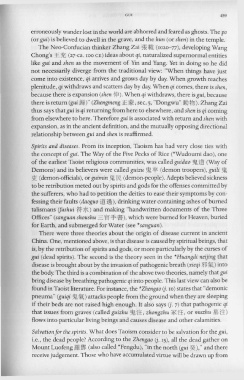Page 499 - The Encyclopedia of Taoism v1_A-L
P. 499
CUI 459
erroneously wander lost in the world are abhorred and feared as ghosts. The po
(or gui) is believed to dwell in the grave, and the hun (or shen) in the temple.
The Neo-Confucian thinker Zhang Zai *~ (1020- 77), developing Wang
Chong's .:E3'E (27-ca. 100 CE) ideas about qi, naturalized supernormal entities
like gui and shen as the movement of Yin and Yang. Yet in doing so he did
not necessarily diverge from the traditional view: "When things have just
come into existence, qi arrives and grows day by day. When growth reaches
plenitude, qi withdraws and scatters day by day. When qi comes, there is shen,
because there is expansion (shen {$I). When qi withdraws, there is gui, because
there is return (gui MY' (Zhengmeng lE~ , sec. 5, "Dongwu" iJJ!Io/J). ZhangZai
thus says thatgui is qi returning from here to elsewhere, and shen is qi coming
from elsewhere to here. Therefore gui is associated with return and shen with
expansion, as in the ancient definition, and the mutually opposing directional
relationship between gui and shen is reaffirmed.
Spirits and diseases. From its inception, Taoism has had very close ties with
the concept of gui. The Way of the Five Pecks of Rice (*Wudoumi dao), one
Demons) and its believers were called guizu *$ (demon troopers), guili *
of the earliest Taoist religious communities, was called guidao * m: (Way of
:se: (demon-officials), or guimin * ~ (demon-people). Adepts believed sickness
to be retribution meted out by spirits and gods for the offenses committed by
the sufferers, who had to petition the deities to ease their symptoms by con-
fessing their faults (daoguo m:~) , drinking water containing ashes of burned
talismans (fushui 1'*f7..k) and making "handwritten documents of the Three
Offices" (sanguan shoushu = '§ -¥ ~), which were burned for Heaven, buried
for Earth, and submerged for Water (see *sanguan).
There were three theories about the origin of disease current in ancient
China. One, mentioned above, is that disease is caused by spiritual beings, that
is, by the retribution of spirits and gods, or more particularly by the curses of
gui (dead spirits). The second is the theory seen in the *Huangdi neijing that
disease is brought about by the invasion of pathogenic breath (xieqi ~*t) into
the body. The third is a combination of the above two theories, namely that gui
bring disease by breathing pathogenic qi into people. This last view can also be
found in Taoist literature. For instance, the *Zhengao (j. ro) states that "demonic
pneuma" (guiqi *~) attacks people from the ground when they are sleeping
if their beds are not raised high enough. It also says (j. 7) that pathogenic qi
tha t issues from graves (called guizhu * ~ , zhongzhu ~ ~, or muzhu JiJ; ~)
flows into particular living beings and causes disease and other calamities.
Salvation for the spirits. What does Taoism consider to be salvation for the gui,
i.e., the dead people? According to the Zhengao (j. IS), all the dead gather on
Mount Luofeng !.1 ~~ (also called *Fengdu), "in the north (gui ~ )," and there
receive judgement. Those who have accumulated virtue will be drawn up from

